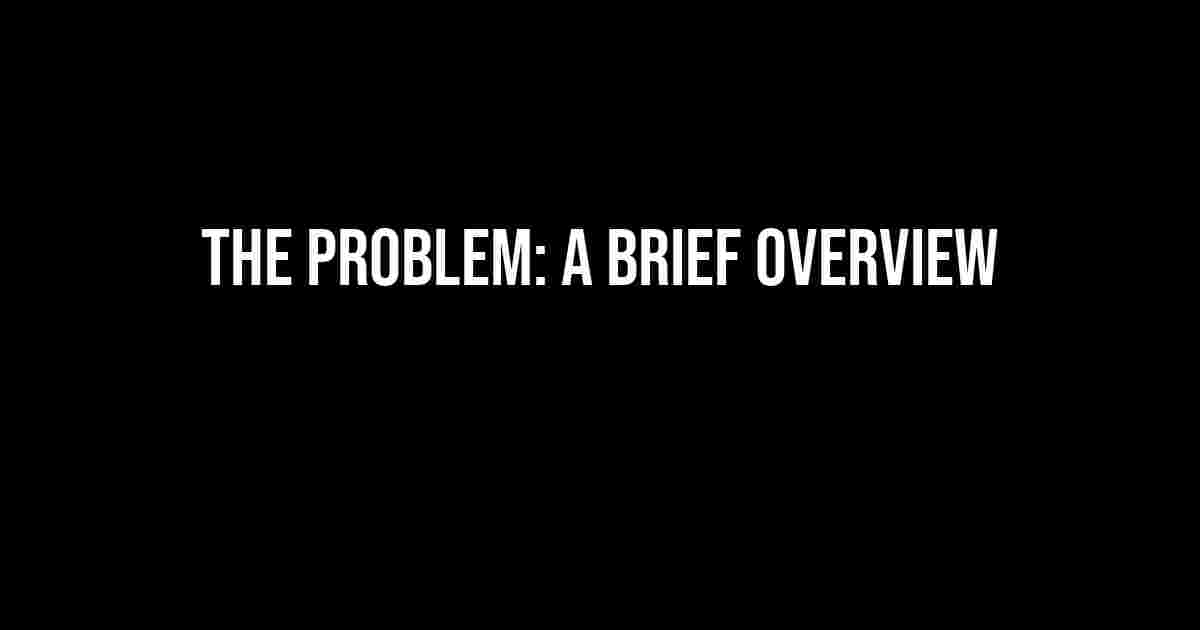Are you tired of dealing with a stubborn in-app redemption sheet that refuses to dismiss itself automatically or when you click the Open Application button in your Swift-based iOS app? You’re not alone! This frustrating issue has been plaguing developers for quite some time, but fear not, dear reader, for we’ve got the solution right here.
The Problem: A Brief Overview
The Apple in-app redemption sheet is a crucial component of the in-app purchase process. It’s where users redeem their purchased products or subscriptions. However, in some cases, this sheet fails to dismiss itself automatically or when the Open Application button is clicked, leaving users stuck with an unresponsive screen.
This issue can be attributed to a variety of reasons, including:
- Incorrect implementation of the
SKPaymentTransactionObserverprotocol - Failing to handle the
paymentQueue(_:updatedTransactions:)method correctly - Not properly dismissing the redemption sheet in the
dismiss(animated:completion:)method - Overriding the wrong method or not overriding the correct one
Step-by-Step Solution to Dismiss the In-App Redemption Sheet Automatically or on Open Application Button Click
Don’t worry; we’re about to dive into the nitty-gritty of solving this issue. Follow these steps carefully, and you’ll be saying goodbye to that pesky redemption sheet in no time!
Step 1: Implement the SKPaymentTransactionObserver Protocol
import StoreKit
class MyViewController: UIViewController, SKPaymentTransactionObserver {
// ...
}
In your view controller, make sure to adopt the SKPaymentTransactionObserver protocol. This will allow you to receive notifications about transactions.
Step 2: Add the Payment Queue Observer
func paymentQueue(_ queue: SKPaymentQueue, updatedTransactions transactions: [SKPaymentTransaction]) {
for transaction in transactions {
switch transaction.transactionState {
case .purchased:
// Handle purchased transaction
break
case .failed:
// Handle failed transaction
break
case .restored:
// Handle restored transaction
break
case .deferred:
// Handle deferred transaction
break
default:
break
}
}
}
In the paymentQueue(_:updatedTransactions:) method, you’ll receive an array of SKPaymentTransaction objects. Iterate through this array, and for each transaction, handle the corresponding state.
Step 3: Dismiss the Redemption Sheet Automatically
func paymentQueue(_ queue: SKPaymentQueue, updatedTransactions transactions: [SKPaymentTransaction]) {
for transaction in transactions {
switch transaction.transactionState {
case .purchased:
// Dismiss the redemption sheet automatically
dismiss(animated: true, completion: nil)
break
case .failed:
// Handle failed transaction
break
case .restored:
// Handle restored transaction
break
case .deferred:
// Handle deferred transaction
break
default:
break
}
}
}
In the .purchased case, call the dismiss(animated:completion:) method to dismiss the redemption sheet automatically.
Step 4: Dismiss the Redemption Sheet on Open Application Button Click
@IBAction func openApplication-buttonClicked(_ sender: UIButton) {
// Dismiss the redemption sheet on Open Application button click
dismiss(animated: true, completion: nil)
}
In your button’s action method, call the dismiss(animated:completion:) method to dismiss the redemption sheet when the Open Application button is clicked.
While implementing the solution, make sure to avoid these common errors:
| Error | Explanation |
|---|---|
| Not adopting the SKPaymentTransactionObserver protocol | Failing to adopt the protocol will prevent your view controller from receiving transaction updates. |
| Not overriding the paymentQueue(_:updatedTransactions:) method | Overriding the wrong method or not overriding the correct one will prevent your app from handling transactions correctly. |
| Not dismissing the redemption sheet in the dismiss(animated:completion:) method | Failing to dismiss the redemption sheet will leave it stuck on the screen. |
Conclusion
By following these steps and avoiding common errors, you should be able to resolve the issue of the Apple in-app redemption sheet not dismissing automatically or on Open Application button click in Swift. Remember to implement the SKPaymentTransactionObserver protocol, handle transactions correctly, and dismiss the redemption sheet when necessary. If you’re still facing issues, double-check your code and ensure that you’ve followed the instructions accurately.
Happy coding, and don’t let that pesky redemption sheet get the best of you!
Frequently Asked Question
Stuck with an Apple in-app redemption sheet that just won’t dismiss? You’re not alone! Get the answers to the most pressing questions about this frustrating issue right here.
Why does the in-app redemption sheet not dismiss automatically after successfully redeeming a code?
The in-app redemption sheet might not dismiss automatically if the `dismiss` method is not called explicitly after the redemption process is complete. Make sure to call `dismiss` on the redemption sheet after receiving a successful redemption response from the App Store.
Why does the in-app redemption sheet not dismiss when I click the “Open App” button?
The “Open App” button is meant to open the app, not dismiss the redemption sheet. To dismiss the sheet, you need to call the `dismiss` method programmatically or implement a custom button to handle the dismissal. You can use a delegate method or a closure to achieve this.
How can I programmatically dismiss the in-app redemption sheet in Swift?
To dismiss the redemption sheet programmatically, simply call `dismiss(animated: true, completion: nil)` on the view controller that presented the redemption sheet. This will animate the dismissal and remove the sheet from the view hierarchy.
Can I use a delegate method to dismiss the in-app redemption sheet?
Yes, you can use a delegate method to dismiss the redemption sheet. Set up a delegate protocol and conform to it in your view controller. Then, call the delegate method from the completion handler of the redemption response to dismiss the sheet.
What are some common mistakes to avoid when implementing in-app redemption sheet dismissal?
Common mistakes to avoid include not calling `dismiss` explicitly, not handling errors properly, and not implementing a delegate method or closure correctly. Make sure to test your implementation thoroughly to ensure the redemption sheet dismisses correctly in all scenarios.

